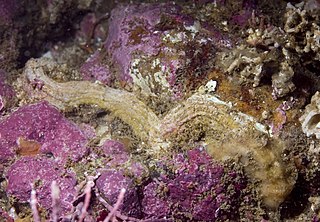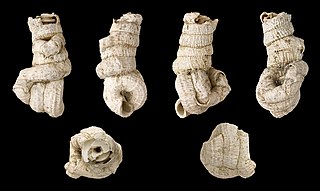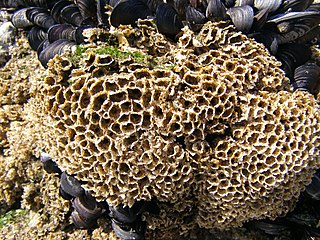
The Chaetognatha or chaetognaths are a phylum of predatory marine worms that are a major component of plankton worldwide. Commonly known as arrow worms, about 20% of the known Chaetognatha species are benthic, and can attach to algae and rocks. They are found in all marine waters, from surface tropical waters and shallow tide pools to the deep sea and polar regions. Most chaetognaths are transparent and are torpedo shaped, but some deep-sea species are orange. They range in size from 2 to 120 millimetres.

A salp or salpa is a barrel-shaped, planktic tunicate. It moves by contracting, thereby pumping water through its gelatinous body, one of the most efficient examples of jet propulsion in the animal kingdom. The salp strains the pumped water through its internal feeding filters, feeding on phytoplankton.

The Serpulidae are a family of sessile, tube-building annelid worms in the class Polychaeta. The members of this family differ from other sabellid tube worms in that they have a specialized operculum that blocks the entrance of their tubes when they withdraw into the tubes. In addition, serpulids secrete tubes of calcium carbonate. Serpulids are the most important biomineralizers among annelids. About 300 species in the family Serpulidae are known, all but one of which live in saline waters. The earliest serpulids are known from the Permian.

The Vermetidae, the worm snails or worm shells, are a taxonomic family of small to medium-sized sea snails, marine gastropod molluscs in the clade Littorinimorpha. The shells of species in the family Vermetidae are extremely irregular, and do not resemble the average snail shell, hence the common name "worm shells" or "worm snails".
Cerithiovermetus is a genus of sea snails, marine gastropod mollusks in the family Vermetidae, the worm snails or worm shells.

Petaloconchus is a genus of sea snails, marine gastropod mollusks in the family Vermetidae, the worm snails or worm shells.

Vermetus is a genus of sea snails, marine gastropod mollusks in the family Vermetidae, the worm snails or worm shells.
Enteroxenos is a genus of very small parasitic sea snails, marine gastropod mollusks in the family Eulimidae.
Pseudovermis is genus of minute sea slugs, specifically aolid nudibranchs, marine gastropod mollusks or micromollusks in the family Pseudovermidae.

Sabellaria is a genus of marine polychaete worms in the family Sabellariidae. The type species is Sabellaria alveolata. These worms are sedentary and build tubes in which to live from sand and shell fragments. Some species are called honeycomb worms and when they occur in great numbers they can form reefs on rocks and other hard substrates. They are filter feeders, extending a plume-like fan of radioles from the end of the tube in order to catch plankton and detritus floating past. They have a distinctive operculum which is used to block the opening of the tube when the radioles are retracted.
Kuphus is a genus of shipworms, marine bivalve molluscs in the family Teredinidae. While there are four extinct species in the genus, the only extant species is Kuphus polythalamius. It is the longest bivalve mollusc in the world, where the only known permanent natural habitat is Kalamansig, Sultan Kudarat in the Philippines.

Protomicrocotylidae is a family of monogenean parasites in the order Mazocraeidea.

Parasagitta setosa is a small arrow worm in the family Sagittidae, previously referred to as Sagitta setosa. It is native to the northeastern Atlantic Ocean, the North Sea and the Mediterranean Sea, and also occurs in the Baltic Sea and the Black Sea.

Thylacodes is a genus of sea snails, marine gastropod mollusks in the family Vermetidae, the worm snails or worm shells. The species in this genus were previously placed in the genus Serpulorbis.

Phyllodocidae is a family of polychaete worms. Worms in this family live on the seabed and may burrow under the sediment.
Tetragonoporus is a genus of cestodes in the order Pseudophyllidea. It is a monotypic genus, and the only species is Tetragonoporus calyptocephalus, previously known as Polygonoporus giganticus. This tapeworm is a gut parasite of whales.

Morum is a genus of sea snails, marine gastropod mollusks in the subfamily Moruminae of the family Harpidae.

Echiuridae is a family of spoon worms in the subclass Echiura. It is a monotypic family, the only genus being Echiurus. These worms burrow into soft sediment on the seabed.

Heterocyathus is a genus of coral of the family Caryophylliidae.

Heteropsammia is a genus of apozooxanthellate corals that belong to the family Dendrophylliidae.














